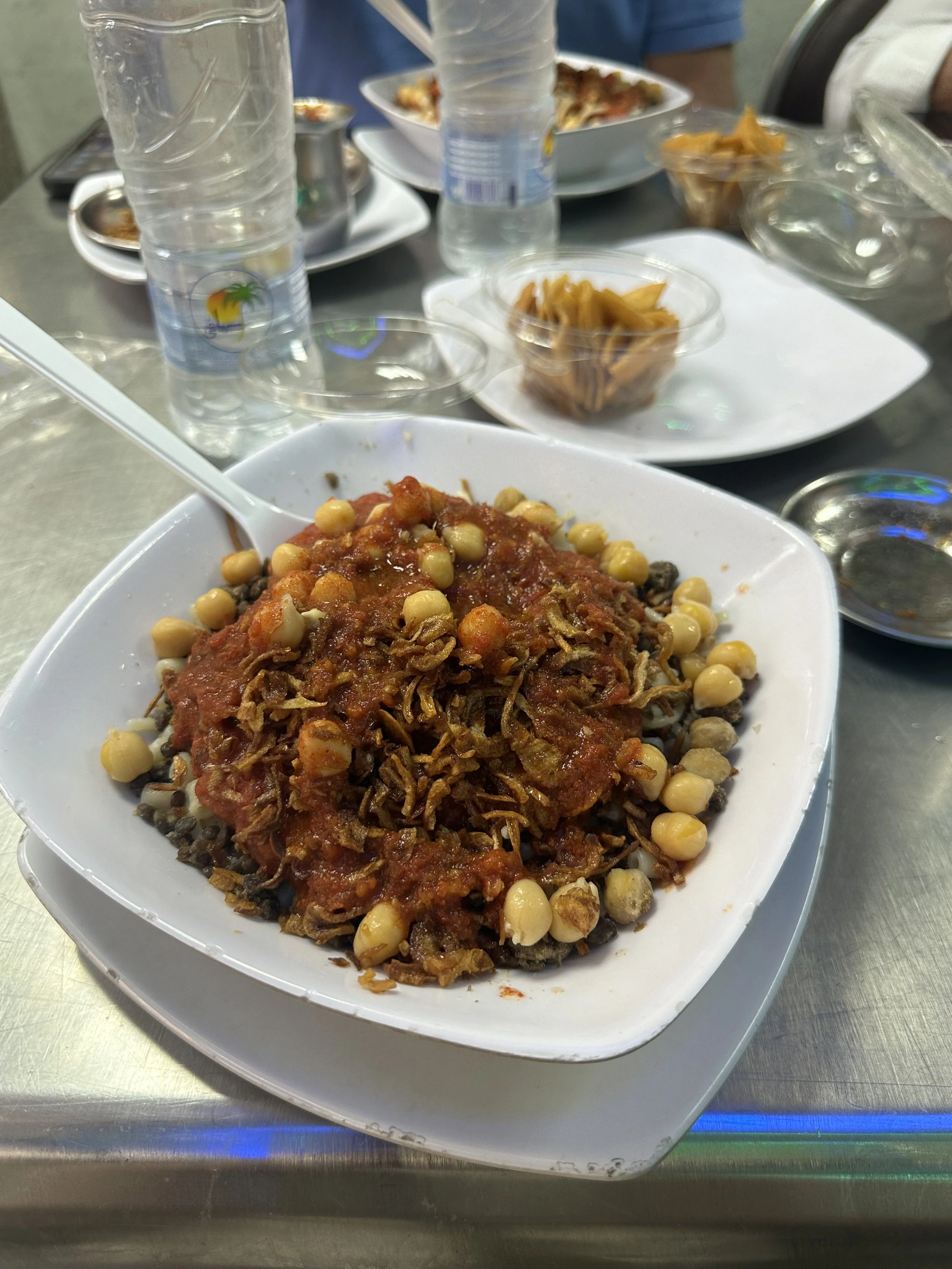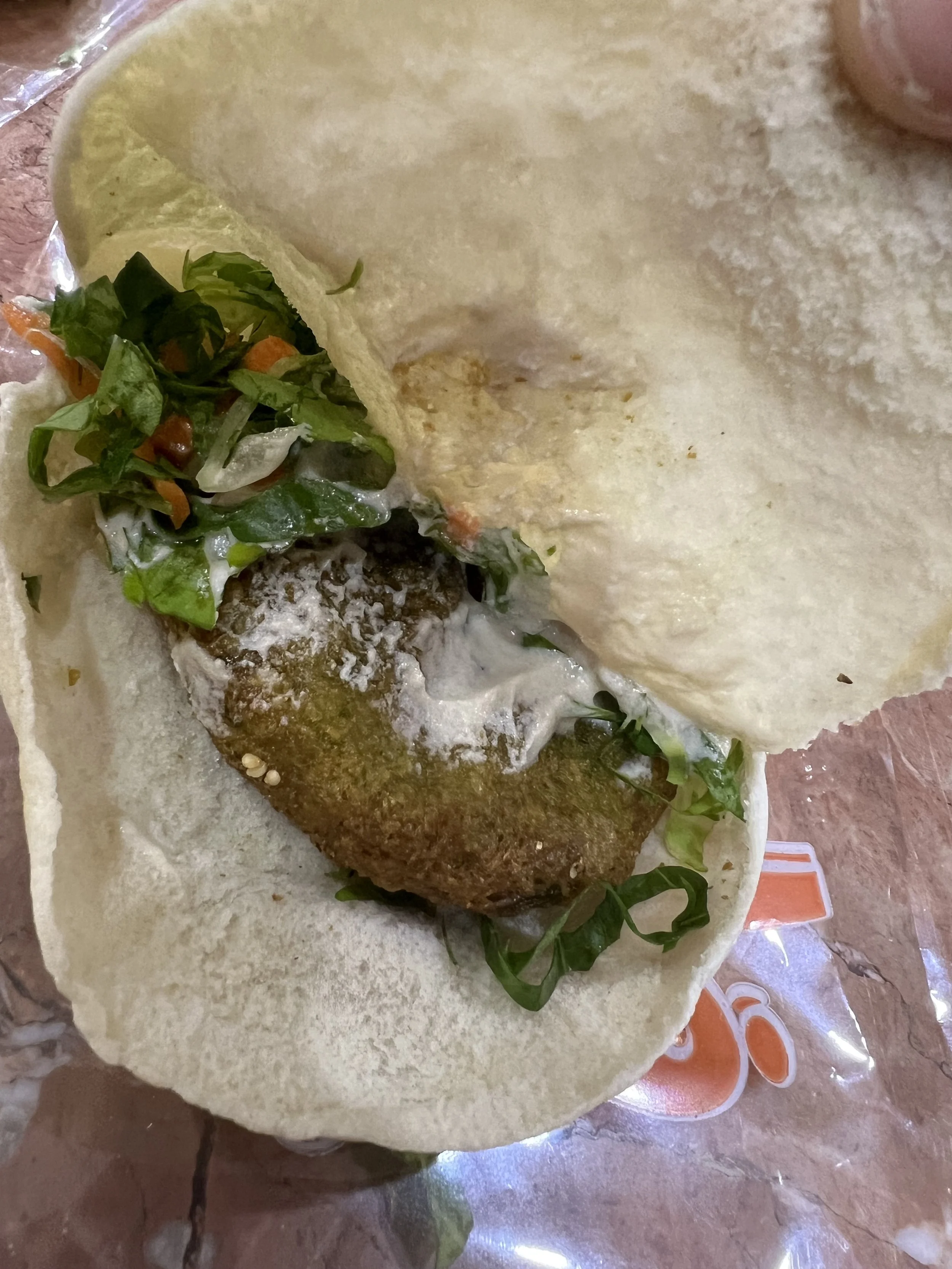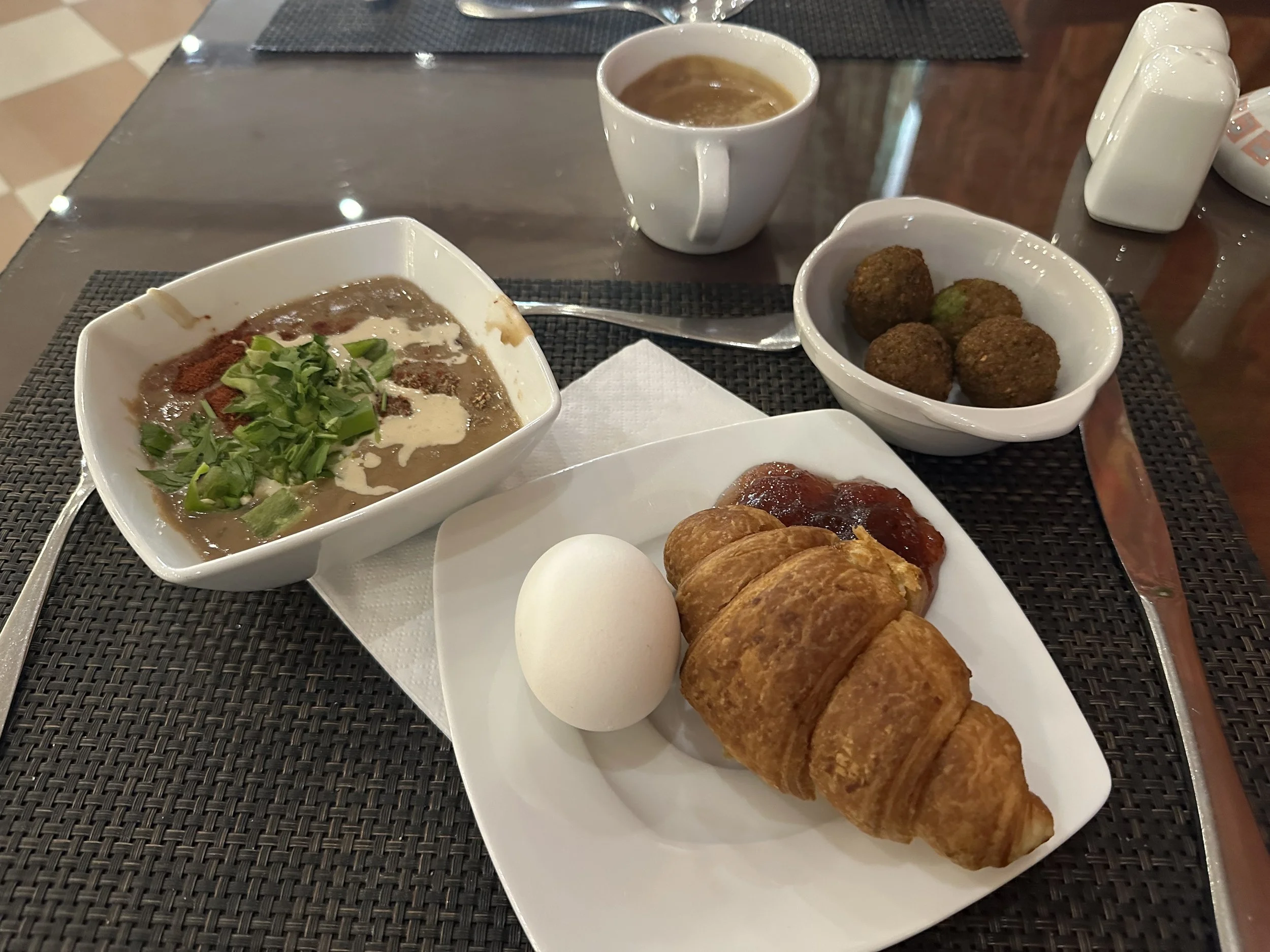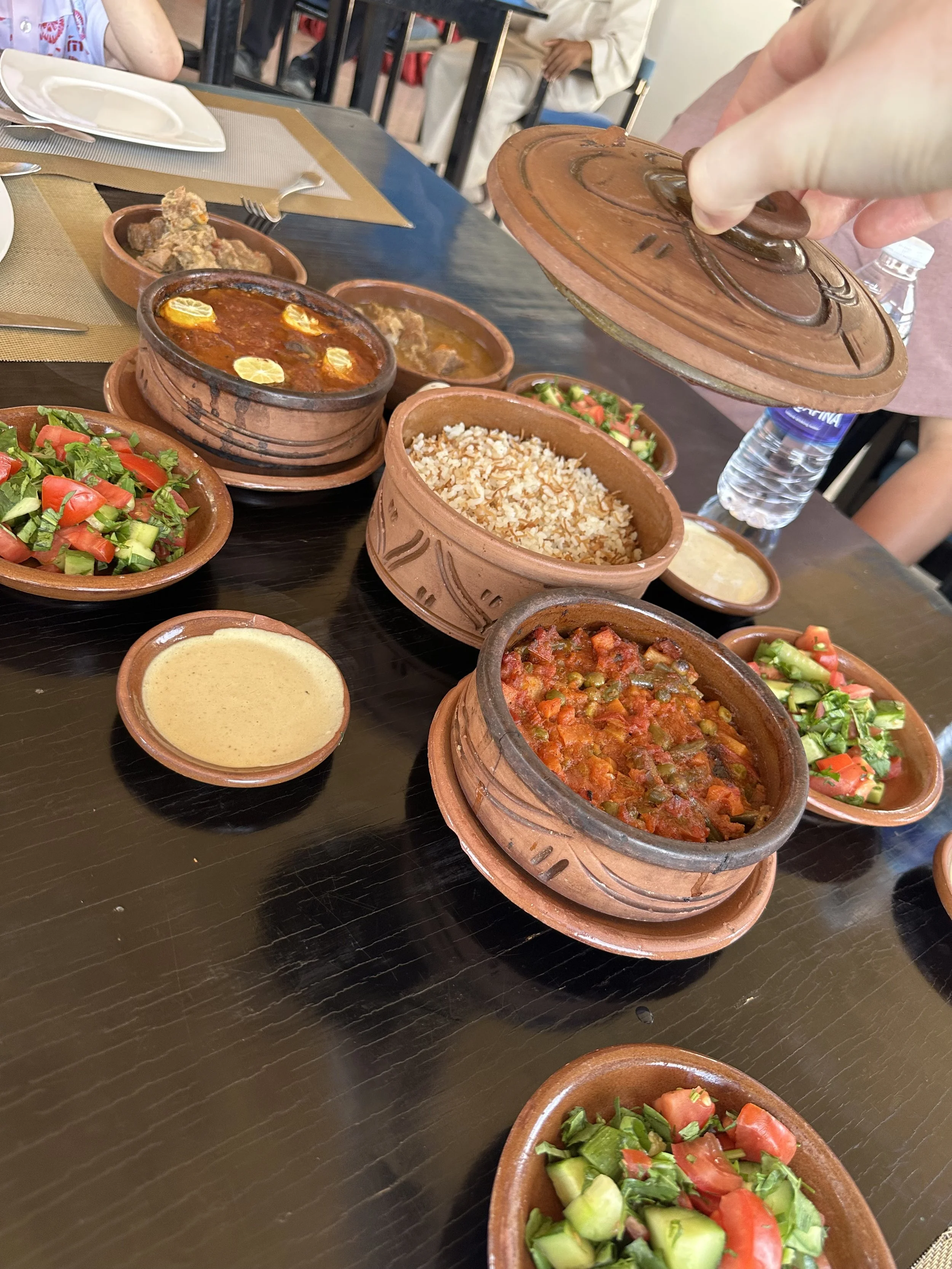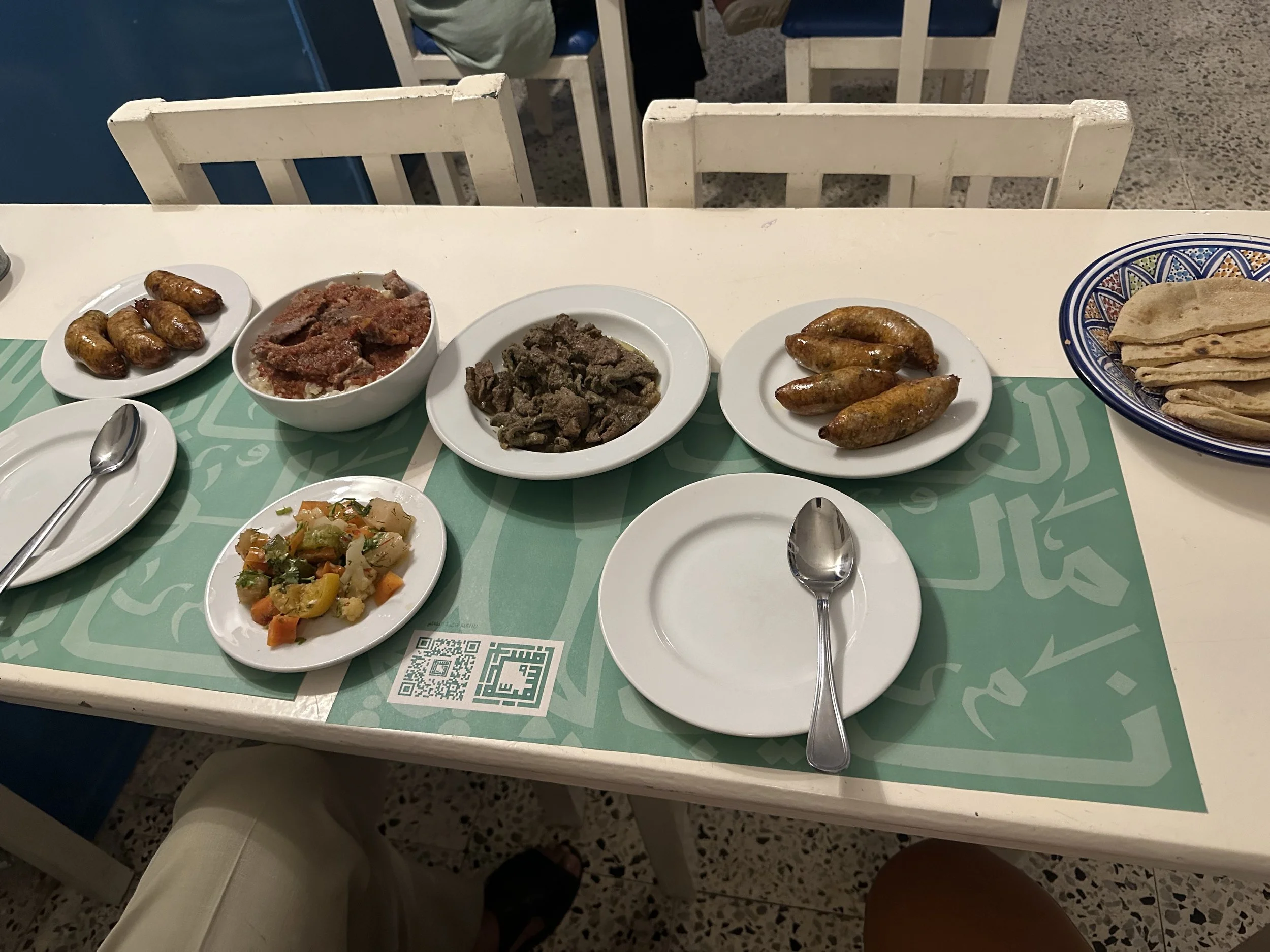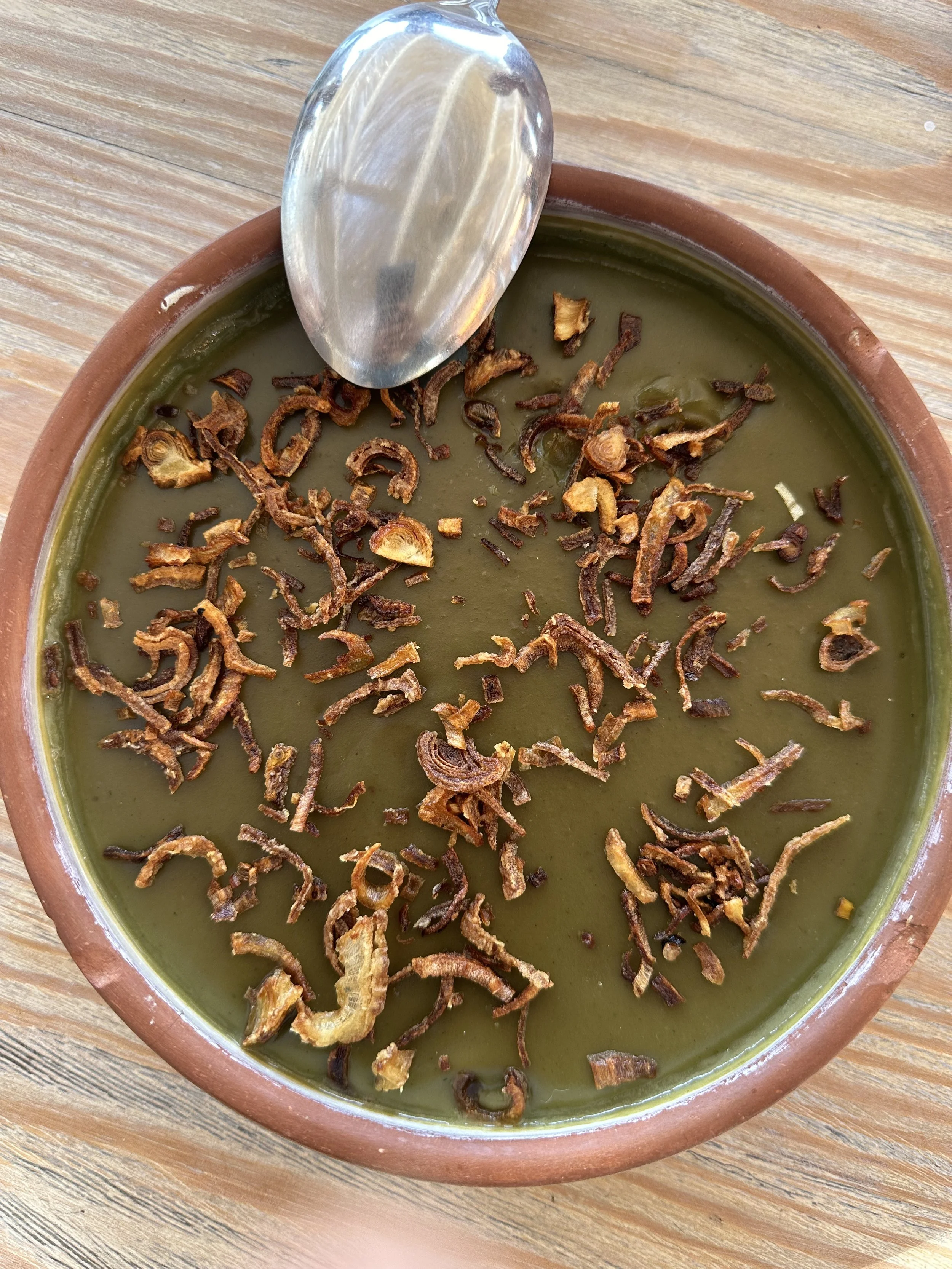Famous Egypt Food - 4 Popular Egyptian Foods to Try!
Molokhiyya (the green soup in the middle-right of the photo) is one of the most famous Egyptian foods.
When people get closer to their Egypt trip, they often ask me, Gus, what are famous Egyptian foods? When I answer them, saying that the four most famous Egyptian foods include Koshary, Falafel, Fuul (stewed fava beans), and molokhiyya (a traditional soup), the response is usually a blank stare. Egypt is not a destination typically known for its food, but hey, it's hard for the food to be the main event when there are Pyramids, Sphinxes, and tombs of the pharaohs to steal the spotlight! I want to share all the famous Egypt food that you will encounter during your trip, so that you can recognize traditional Egyptian food, know what Egypt street food to try, and have some great Egyptian dishes to order when you try local restaurants.
I've lived in Egypt off and on for 12 years, speak fluent Egyptian Arabic, and now get to help hundreds of travelers visit Egypt every year on group tours and private tours. Want help planning your trip to Egypt? Fill out the interest form and I'll get in touch to share how I can help with your Egypt adventure!
What Food is Egypt Known For
Egypt is not usually a destination known for its food at all, but possibly the four most popular or well-known Egyptian dishes are Koshary, Falafel, Fuul, and Molokhiyya. Let's talk about what each dish is, and most importantly, what destinations you can try it at during your Egypt adventure!
Koshary - Egypt's National Dish
Koshary is Egyptian carb heaven!
What is koshary: Koshary is often referred to as Egypt's national dish and it is a carb paradise. Koshary is a mix of spaghetti noodles, macaroni noodles, chickpeas, lentils, and rice, and is topped with a vinegar and garlic sauce, fried onions, tomato sauce, and as much hot sauce as you can handle! Koshary is typically eaten as a lunch food, and is very popular with Egyptian Coptic Orthodox Christians when they are fasting (which means they still eat, but they eat a vegan diet only). Since koshary is naturally vegan, naturally delicious, very cheap (usually only $1-2 USD for a meal), it's a favorite choice for many!
Where to get koshary: I recommend trying koshary in Cairo, the home to lots of great koshary spots. Hands down the best place is Koshary Abou Tarek, which eating at is an experience in and of itself, and good chains to try koshary include Koshary Sayed Hanafy or Koshary el Tahrir (Google either chain and you'll see locations all over Cairo)
Molokhiyya - Egypt's (other) National Dish
If you ask any Egyptian what Egypt's national dish is, and they don't say koshary, chances are high they will say molokhiyya instead, another very popular Egyptian food.
What is Molokhiyya: Molokhiyya often grosses people out when they see it (it looks like a slimy green soup), but for folks who give it a try, it often becomes a fan-favorite. Molokhiyya is a soup made from the jute mallow plant, and has a very fatty, salty, and earthy flavor. I am personally not a molokhiyya convert, but I am shy to mention this, because it scandalizes any Egyptian person I mention it to, and always is followed by an invitation to visit their mother, because I just "Haven't tried the right molokhiyya yet!"
Molokhiyya is typically enjoyed for lunch, and is never by itself - it will often be paired with rice and meat, like rabbit or chicken. It's eaten by spooning a small amount of the soup onto rice, combining it with a bite of chicken or rabbit, and putting the combination in your mouth for a blast of Egyptian flavor!
Where to get Molokhiyya: Molokhiyya, like most Egyptian food, is best to enjoy in someone's home - nothing beats homemade molokhiyya. However, if you want to try molokhiya at a restaurant, I recommend a homemade-kitchen, like Hakeem's Tabkhaa Space or Fasahet Somaya, although both of these homemade-kitchens only have molokhiyya on the menu on specific days, so you'll need to check their menu day-of in order to make sure it's being served that day. If you want to go somewhere that will definitely have molokhiyya on the menu, Zooba or Abu el Sid are good options.
Falafel (Taa'miya)
Falafel is often eaten for breakfast, in a sandwich
Falafel, also referred to as Taa'miya, is identical to the falafel served in the USA, with two key differences:
1. It's made with fava beans, instead of chickpeas
2. It's way more delicious!
What is falafel: Falafel is a classic Egyptian breakfast food, but it can also be eaten for lunch or dinner as well. Falafel can be eaten in individual pieces (usually served with other breakfast foods, like fuul, bread, eggs, eggplant, cheese, tahini, etc.), or it can be put into pita bread (called "balady bread" in Egypt) with lettuce, tomato, cucumber, and tahini and eaten as a sandwich.
Falafel, like koshary, is naturally vegan! Want information on other vegan and vegetarian food in Egypt? I have a blog post on that very topic!
Where to get falafel: The best place to buy falafel is on the street - it's my favorite Egyptian street food! El Sharouk has good falafel in downtown Cairo, Abdullah Bashandy is another great falafel joint close to downtown Cairo, and in Alexandria, the falafel at Mohamed Ahmed is amazing!
Fuul (stewed fava beans)
What is fuul: Fuul (pronounced just like the word “fool”) has been eaten in Egypt since the time of the ancient pharaohs! It's made by stewing fava beans slowly (often overnight), until the beans completely dissolve and turn into a delicious, mushy, soft mass, almost like refried beans, but a more liquid consistency. Like falafel, fuul is a breakfast food, and is served in a bowl and scooped up with generous pieces of ayesh balady (Egyptian pita bread), or it's put into the pita bread itself and eaten like a sandwich.
What is ful medames: Ful medames is just like fuul, but when someone says they have ful medames, this usually means it's one step removed - the fava beans are usually cooked, but not cooked to oblivion like the fuul that has the consistency to go in a sandwich or be used as a dip for pita bread.
Besides the croissant, this is a classic Egyptian breakfast: fuul, falafel, and a hard-boiled egg
Where to get fuul: Fuul is totally vegan, just like falafel, and it's another great food to get on the street, but my favorite fuul in Cairo is actually at Zooba, or Alexandria's Mohamed Ahmed is another great choice. And if you are staying at a 5-star hotel, they will almost always have what I call the "fuul bar" - a giant urn full of fuul, with all the accoutremonts, like olive oil, salt, pepper, chili, cumin, diced onions, diced tomatoes, green pepper, tahini and the obligatory lemon wedge to squeeze over the whole mixture.
Other Traditional Egyptian Food
In addition to koshary, molokhiyyah, falafel, and fuul, there are many other traditional Egyptian foods that you can try on your Egypt adventure. This is not an exhaustive list, though! Want other ideas for Egyptian foods? Check out 9 Foods to Try in Egypt!
Kofta
Kofta and Shish Tawook as part of one of my go-to entrees in Egypt, a “mixed grill”
Kofta, or something like it, is eaten in many places around the world, and it's one of the most popular ways to eat meat in Egypt. Kofta is made from either ground beef or ground lamb, mixed with spices (often salt, pepper, cumin, and parsley) and grilled on a charcoal flame on a metal skewer. It's typically served at lunchtime, and is often eaten alongside tahini, rice, and bread.
Shish Tawook
Shish Tawook is common throughout the Middle East, and along with Kofta, is a very popular way to eat meat. Chunks of chicken are skewered and grilled on the same charcoal flame used to cook kofta, and the result is delicious when dipped in some tahini or eaten alongside rice and veggies.
Are you ready for a break from Egyptian food, and are looking for an Egypt travel guide? Check out my Egypt travel guide that has tons of advice for your Egypt adventure, plus my best tips and tricks on where to visit during your trip!
Macarona Bechamel
The Macarona Bechamel is in the middle of the table - I can’t wait to dig in!
Macarona bechamel is top notch Egyptian comfort food - take penne noodles, add ground beef, a creamy bechamel sauce, throw it in the oven, bake it to perfection, and you have macarona bechamel! This is one of those dishes that I have limited my intake of (it's not the healthiest), but I can never resist ordering some if it's on the menu, and if I'm eating in a local Egyptian home and it's on the table, I won't walk away without at least one giant serving!
Tagin (Tajine)
Two different tagins are in this photo - one is a vegan tagin, and the other, bamiya bil lahmeh (okra with beef) - my favorite!
Egyptian tagins are similar to their Moroccan counterpart (called "tajine" in Moroccan cuisine). A tagin can be made out of any meat or vegetable, put into a clay bowl, and baked in the oven, with either a tomato-based sauce, or a white, creamy sauce.
My favorite tagin is "bamiya bil lahma", or okra with beef in a tomato-based sauce, but any tagin is a friend of mine. Another tagin that I love is the artichoke and chicken tagin on the menu at Abou El Sid Restaurant in Cairo - large chunks of artichoke and pieces of chicken are baked in a white cream sauce in a clay tagin, perfect for folks who love artichokes!
For vegetarians, a tagin of vegetables is usually the best option on the menu - mixed vegetables cooked in a tomato-based sauce is served in a tagin, accompanied by potatoes, rice, bread, and tahini sauce for dipping.
Mumbar
There are two plates of mumbar in this photo - if you just imagine them as rice-filled sausages (and don’t think about the intestines part), they’re easy to eat and delicious!
Mumbar is often a polarizing Egyptian dish, because the most important ingredient is animal intestines, but if you can get past that, this popular Egyptian food is delicious! Rice seasoned with cumin, cinnamon, salt, and pepper is stuffed inside of intestines, and it reminds me of a spicy, delicious, sausage, except for instead of meat inside the sausage, there's rice!
Mumbar is one of the specialties at Fasahet Somaya, but she only serves it once a week, so you need to check her daily menu in order to see if it's being offered that day.
Besara
Besara is not usually a crowd-pleaser, but I love this Egyptian fava bean dip!
I call besara the Egyptian version of hummus, and while the taste and texture are not similar to hummus, besara is a dip, typically scooped up with generous pieces of pita bread, just like hummus. While humus's main ingredient is chickpeas, the main player in Egyptian besara is fava beans. Cooked fava beans are combined with parsley, cilantro, dill, garlic, onion, cumin, and mint, and blended to perfection, topped with fried onions (just like koshary), then served with ayesh balady (traditional Egyptian pita bread) for dipping.
Even though my guests usually say they prefer hummus to besara, this green dip is a good way to get more vegetables, protein, and fiber into your diet when in Egypt, and it's also vegan.
Moussaka
Egyptian moussaka (pronounced "muss-seh-AHH" in Egyptian Arabic) is similar to its Greek counterpart, although Egyptian moussaka is almost always 100% vegan!
Moussaka is a heavenly combination of tomatoes, eggplants, and onion, stewed until it practically disintegrates and combines into melt-into-your-mouth goodness. Moussaka is typically served at breakfast time, and is usually eaten with pita bread, which is used as a makeshift spoon for the soupy-like consistency of the moussaka.
Om Ali
The last food I'll share is a dessert - it was invented in Egypt and is almost 1,000 years old!
Om Ali is often referred to as "Egyptian bread pudding", but I feel like this isn't a great association, since this Egyptian dessert stands on its own, and my guests usually express confusion after trying it, saying that it doesn't remind them of bread pudding at all.
To make Om Ali, Egyptians take pastry pieces, add in pistachios, golden raisins, sugar, dried coconut, and cream, and then bake the concoction in a clay pot (just like a tagin) in the oven, until the top creates a golden-brown film that can be pierced with a fork, revealing the creamy goodness underneath!
So now when you go to Egypt, you can confidently say you know the most famous Egypt food, and have several ideas for traditional Egyptian dishes to try!
Of these foods, what ones do you want to order on your trip? Have you tried any of these Egyptian dishes, and what did you think? Write a comment below with your thoughts and questions - I love reading and replying to everyone's comments!


